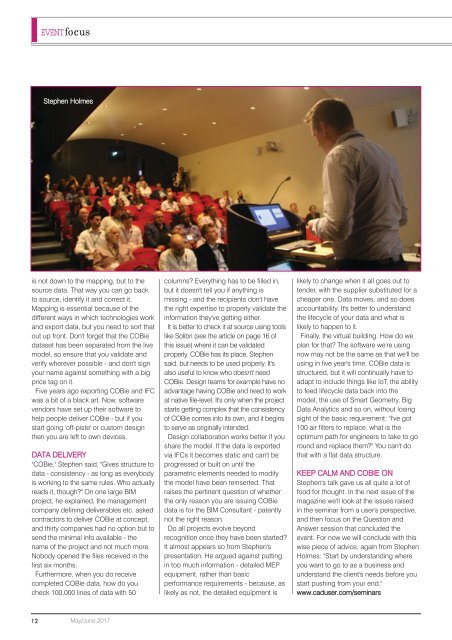You also want an ePaper? Increase the reach of your titles
YUMPU automatically turns print PDFs into web optimized ePapers that Google loves.
EVENTfocus<br />
Stephen Holmes<br />
is not down to the mapping, but to the<br />
source data. That way you can go back<br />
to source, identify it and correct it.<br />
Mapping is essential because of the<br />
different ways in which technologies work<br />
and export data, but you need to sort that<br />
out up front. Don't forget that the COBie<br />
dataset has been separated from the live<br />
model, so ensure that you validate and<br />
verify wherever possible - and don't sign<br />
your name against something with a big<br />
price tag on it.<br />
Five years ago exporting COBie and IFC<br />
was a bit of a black art. Now, software<br />
vendors have set up their software to<br />
help people deliver COBie - but if you<br />
start going 'off-piste' or custom design<br />
then you are left to own devices.<br />
DATA DELIVERY<br />
"COBie," Stephen said, "Gives structure to<br />
data - consistency - as long as everybody<br />
is working to the same rules. Who actually<br />
reads it, though?" On one large BIM<br />
project, he explained, the management<br />
company defining deliverables etc. asked<br />
contractors to deliver COBie at concept,<br />
and thirty companies had no option but to<br />
send the minimal info available - the<br />
name of the project and not much more.<br />
Nobody opened the files received in the<br />
first six months.<br />
Furthermore, when you do receive<br />
completed COBie data, how do you<br />
check 100,000 lines of data with 50<br />
columns? Everything has to be filled in,<br />
but it doesn't tell you if anything is<br />
missing - and the recipients don't have<br />
the right expertise to properly validate the<br />
information they've getting either.<br />
It is better to check it at source using tools<br />
like Solibri (see the article on page 16 of<br />
this issue) where it can be validated<br />
properly. COBie has its place, Stephen<br />
said, but needs to be used properly. It's<br />
also useful to know who doesn't need<br />
COBie. Design teams for example have no<br />
advantage having COBie and need to work<br />
at native file-level. It's only when the project<br />
starts getting complex that the consistency<br />
of COBie comes into its own, and it begins<br />
to serve as originally intended.<br />
Design collaboration works better if you<br />
share the model. If the data is exported<br />
via IFCs it becomes static and can't be<br />
progressed or built on until the<br />
parametric elements needed to modify<br />
the model have been reinserted. That<br />
raises the pertinent question of whether<br />
the only reason you are issuing COBie<br />
data is for the BIM Consultant - patently<br />
not the right reason.<br />
Do all projects evolve beyond<br />
recognition once they have been started?<br />
It almost appears so from Stephen's<br />
presentation. He argued against putting<br />
in too much information - detailed MEP<br />
equipment, rather than basic<br />
performance requirements - because, as<br />
likely as not, the detailed equipment is<br />
likely to change when it all goes out to<br />
tender, with the supplier substituted for a<br />
cheaper one. Data moves, and so does<br />
accountability. It's better to understand<br />
the lifecycle of your data and what is<br />
likely to happen to it.<br />
Finally, the virtual building. How do we<br />
plan for that? The software we're using<br />
now may not be the same as that we'll be<br />
using in five year's time. COBie data is<br />
structured, but it will continually have to<br />
adapt to include things like IoT, the ability<br />
to feed lifecycle data back into the<br />
model, the use of Smart Geometry, Big<br />
Data Analytics and so on, without losing<br />
sight of the basic requirement: "I've got<br />
100 air filters to replace, what is the<br />
optimum path for engineers to take to go<br />
round and replace them?" You can't do<br />
that with a flat data structure.<br />
KEEP CALM AND COBIE ON<br />
Stephen's talk gave us all quite a lot of<br />
food for thought. In the next issue of the<br />
magazine we'll look at the issues raised<br />
in the seminar from a user's perspective,<br />
and then focus on the Question and<br />
Answer session that concluded the<br />
event. For now we will conclude with this<br />
wise piece of advice, again from Stephen<br />
Holmes: "Start by understanding where<br />
you want to go to as a business and<br />
understand the client's needs before you<br />
start pushing from your end."<br />
www.caduser.com/seminars<br />
12<br />
May/June 2017

















